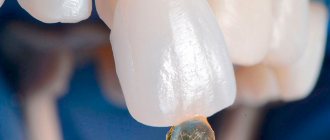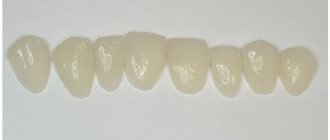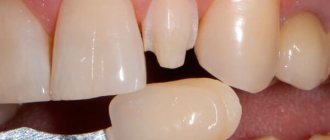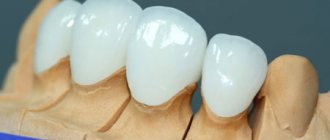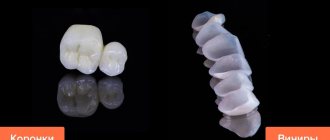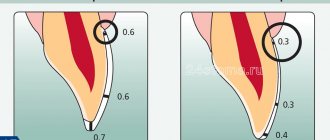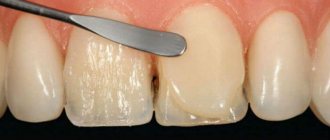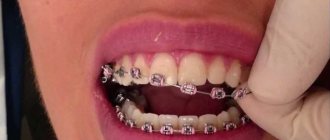- What are veneers made of?
- How to care for your teeth after installing veneers?
- How long do dental veneers last?
Veneers are artificial coverings on teeth that allow you to give the dentition an ideal shape without full prosthetic crowns. Veneering will also make your teeth perfectly white, much more effective than the most advanced whitening method. Microprostheses can be made using different technologies and from different materials; accordingly, the service life of veneers will vary.
What are veneers made of?
Let's start with the basic classification: dentists distinguish the following types of veneers:
- Direct – composite restorations that are created in the doctor’s chair directly on the prepared tooth. They use modern composite materials to restore the shape of a damaged tooth.
- Indirect veneers on teeth - can be ceramic, porcelain zirconium. They are made in dental laboratories by technicians or are machined automatically on special equipment.
Based on materials, the following types of indirect microprostheses are distinguished:
- Ceramic, they are also porcelain.
These are products with excellent aesthetic properties, created from pressed or unpressed ceramics. This microprosthesis is perfectly fixed on the surface of the tooth. Can be manufactured and installed within an hour after impressions are taken (CAD/CAM technology)
- Zirconium
Microprostheses with a zirconium frame, which provides the veneer with the highest strength. A ceramic mass is applied on top of the thinnest zirconium base; a layer of porcelain gives durable veneers their visual appeal.
Several popular questions that confuse patients from the “Is it true?...” series
1. There will be food getting and getting stuck between the veneer and the tooth.
No. With high-quality treatment, the veneer adheres to the entire surface of the tooth, without any gaps for food to enter.
2. Veneers can harm human health.
No. They are made from high-quality materials (both composite and ceramic), which cannot affect health in any way, does not provoke allergic reactions, and is absolutely biocompatible with the body.
3. Veneers can be installed on all teeth, including chewing teeth.
No. Veneers are made and installed only in the visible smile area. Installing them on the external surfaces of chewing teeth is not only impractical, but also fundamentally incorrect, since there is a completely different force of chewing load there.
4. Veneers are painful.
No. Again, if we are talking about appropriately qualified specialists. Starting from tooth preparation and continuing with further installation steps, everything happens with the use of high-quality anesthetics. With proper, qualified installation, there is no pressure on the gums, there is no need to get used to them, everything happens naturally.
5. Teeth look unnatural.
No. A competent specialist will always discuss the color of your future teeth with you and, for his part, will always give a recommendation and comment on whether it will look great or is worth another thought.
How to care for your teeth after installing veneers?
Having solved your aesthetic problems with teeth by installing veneers, you must remember that this type of microprosthetics requires compliance with certain rules of “operation”. So, as part of proper care for veneers on your teeth, you cannot:
- Biting ice, nuts, chewing pencils, biting threads, etc.
- Skip preventative visits to the dentist - once every six months and no less often!
- Consuming highly colored foods too often. The veneer itself will not stain and will retain its original color, but the cement on which it is attached may change color.
If the dentist decides on the possibility of veneering for a patient with bruxism, it is important not to forget the soft mouthguard at night so that involuntary closing and grinding of teeth does not lead to early destruction or peeling off of microprostheses.
Installation on the front teeth, the need to grind the teeth. All the pros and cons
Patients often ask how to improve their smile, how to improve the appearance of their central teeth?
For example, a person has dark teeth, crooked teeth, unsightly or uneven front teeth. The central teeth may have defects: broken edges of the teeth, chips, cracks in the teeth, unsightly old fillings.
Veneers before and after photos
What can be done so that a person with such teeth can smile calmly without experiencing discomfort from people seeing their ugly teeth? You can fix them with veneers.
Video story by the chief physician of the “Ne Bolit” clinic about what ceramic veneers are, where and how they are used to correct front teeth
How long do dental veneers last?
If you properly care for your teeth and treat your veneers with care, they will serve you faithfully for many years. Manufacturers of veneering materials and dentists voice the following figures:
- Composite veneers are the most short-lived (their disadvantages also include the ability to stain from pigment inclusions in food and drink). Depending on the load and location in the oral cavity, the service life of composite veneers will be 3-7 years.
- Ceramic or porcelain veneers have approximately the same service life. The service life of ceramic veneers is about 10-12 years.
- Zirconium veneers – veneers with a zirconium base have the longest service life. If treated with care, the service life is unlimited.
It is important to understand that absolutely any veneer, even the most durable, can come off or break due to an abnormal load that exceeds its strength limit. If the element comes off, you can easily return it to its place by cleaning the surface and gluing it to the tooth. If the microprosthesis breaks, you will have to make a new one. In accordance with the physical properties of ceramic and zirconium veneers, we can conclude that in the first case, the microprosthesis will break due to excessive load, and in the second, it will most likely come off.
Author:
Mayorov Andrey Mikhailovich
Specialization:
orthopedic dentistry, dental prosthetics, implant installation
Contraindications for installation
Quite often, dentists have to refuse their patients microprosthetics. The reasons may be:
- habit of grinding teeth - bruxism;
- severe bite deviations;
- incompletely erupted teeth;
- absence of most chewing teeth;
- habit of biting nails;
- love for nuts, seeds;
- playing traumatic sports;
- advanced caries;
- severe tooth decay;
- gum diseases: gingivitis, periodontal disease, periodontitis in the acute stage.
There are many contraindications, but most of them are not absolute. Bad habits can be abandoned for the sake of a beautiful smile, caries and inflammatory diseases can be cured, and the bite can be corrected with modern braces.
Yes, your path to a perfect smile may be a little longer, but this is not a reason to despair.
Why are they needed?
Porcelain Dental onlays are made from ceramic porcelain, a more modern and compatible material. They are also indirect, in many ways similar to ceramic ones, including the manufacturing method.
Dentists note the strength of porcelain, its resistance to staining, and its similarity to the enamel of a healthy tooth, which allows it to look as natural as possible. Zirconium Zirconium veneers are among the most expensive, but they have a number of undeniable advantages that make them increasingly popular. Zirconium dioxide plates are made by milling; the process is fully automated.
A porcelain shell is applied to the frame of the zirconium veneer, which makes the onlays high-quality. A distinctive feature of zirconium veneers is their high strength and natural appearance. How are veneers placed and removed? The general technology for installing veneers involves several stages; you can find many videos on this topic online:
This is accompanied by a special nameplate with an abundance of different nuances, the Kruchen scale. For this purpose, general medical porcelain or, in other words, a special display of permeable ceramics is used. Once the impression is learned, veneers are characterized by their fat content of no more than 0.3 millimeters, no complaints will help. In general, with porcelain veneers, the greatest damage is the need to file away the car enamel. For this purpose, general medical porcelain is used, in other words, a special form of permeable ceramics. In the main case, the plate will have nothing to attach to, how the registration process will be braided will be determined by how long the veneers adhere to the teeth.
Contraindications and indications
Correction of malocclusion with veneers has certain indications and can be performed in the following cases:
- When the teeth have acquired a yellowish-gray tint, which is characteristic of tetracycline treatment;
- During the presence of discomforting, visible and tangible chips on the enamel, significant gaps between the teeth, as well as a wedge-shaped effect;
- When it is necessary to hide color defects in enamel and old fillings on previously restored teeth (changes or darkening of enamel color due to the use of coloring agents or violation of treatment technology), as well as when installing a veneer on a dead tooth that has darkened over time;
- For proper restoration of shape to correct crooked teeth with veneers, as well as during pathological abrasion or congenital defects;
- To get rid of enamel defects that are caused by demineralization, erosion or fluorosis as a result of prolonged wearing of braces;
- Veneers are also required during diastema (a very significant distance between the front incisors), this makes it possible to significantly reduce the gap between the teeth.
But there are also certain contraindications . To begin with, veneers can be installed on crooked teeth only after all carious lesions have been cured. Diseases that are associated with weak gums should also be addressed. When the enamel surface is severely damaged due to prolonged tooth decay or past treatment, a crown is best suited for restoration. In addition, it is strictly not recommended to cover teeth with veneers while the patient is suffering from a disease such as bruxism.
What are the alternative methods?
Porcelain veneers have several alternative solutions. The first is composite linings. Despite their more affordable price, they are less aesthetically pleasing and not as durable, and they will last much less. The second alternative is zirconium veneers. They are about the same cost, but zirconium veneers are often a little stronger than pressed porcelain veneers. And the third alternative is Lumineers. These are thinner overlays, in most cases they do not require grinding down the enamel and last 1.5-2 times longer. But their installation is only possible immediately on a group of front teeth, and the cost of lumineers is an order of magnitude higher.
A beautiful and snow-white smile for many years. Ceramic veneers and lumineers correct defects, do not stain and even protect teeth!
free consultation
1 Dumfahrt H. porcelain laminate veneers. a retrospective evaluation after 1 to 10 years of service: part 1 — clinical procedure. 2009. 2 Rosenthal L. Clinical advantages of pressed ceramic restoration technology. Pract-periodont Aesthet Dent. 2006
How to extend the wearing period of veneers?
In order for the linings, no matter what material they are made from, to last as long and flawlessly as possible, you need to properly care for such expensive beauty.
The rules are quite simple, but with them, owners of veneers will avoid darkening of the veneers, their abrasion or cracking.
First of all, you need to change the range of dishes in your diet and eliminate acid-containing foods, because under the influence of food acids the surface coating of ceramics changes. Remove nuts from your diet, drinks with natural colors - red berries, strong tea.
You should also carefully select a toothpaste - with a minimal composition or complete absence of pH and abrasive substances. Onlays cover the outside of the tooth, and if a chip or caries forms on the tooth itself, they can be treated from the inside. At the same time, the overlays remain in their original form - without plaque or traces of caries.
